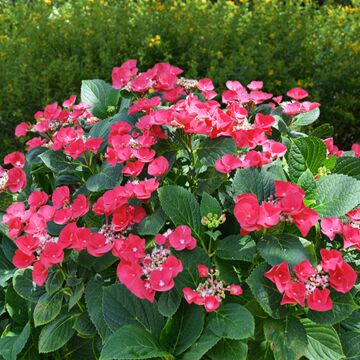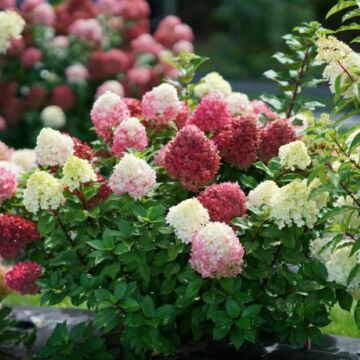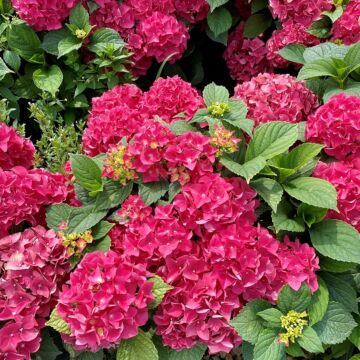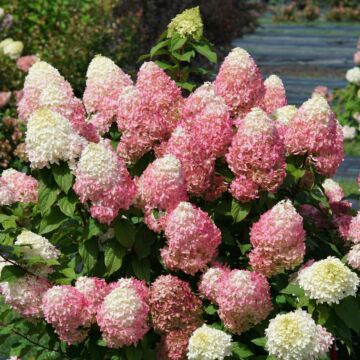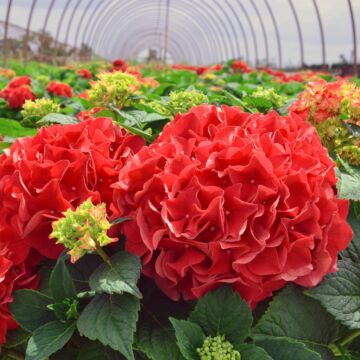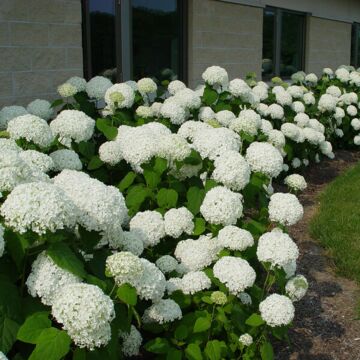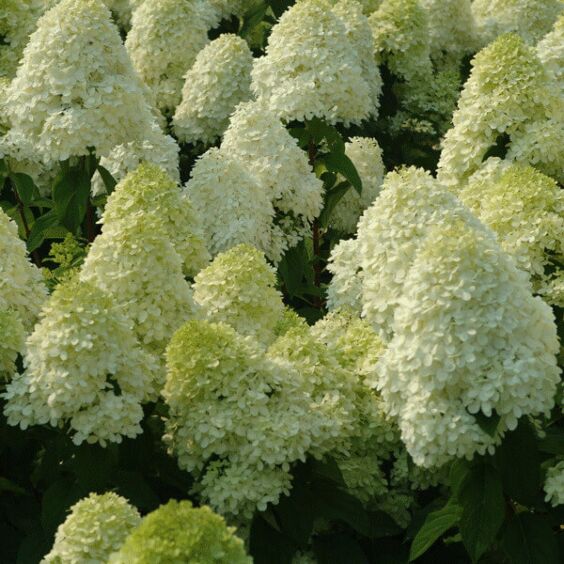
Growing zones
See Zone Map >Status: In stock
Please note: #5 containers cannot be shipped to Arizona, California, Idaho, Montana, Nevada, Oregon, Utah, Washington due to size restrictions.
The following hallmark traits make the Limelight Panicle Hydrangea a standout choice for gardeners:
- Sun, Part Sun/Shade, Shade
Mature Plant Size (H x W): 6-8' x 6-8'
Bloom Season: Summer, Fall
- Attracts Bees
- Salt Tolerant
- Low Maintenance
- Long Blooming
- Award Winning
- Cut Flower
- Attracts Pollinators
Planting and Care for Limelight Hydrangea
This guide offers detailed instructions to help you create a thriving environment for your Limelight Hydrangea plants, covering everything from initial preparation to ongoing maintenance.
Preparation
- Plant Limelight Hydrangea from March to November.
- These shrubs need damp soil high in organic matter. Improve poor soil areas by digging in plenty of well-decayed manure or compost a few months ahead of planting.
- Pick a spot that has dappled sunlight or morning sun and afternoon shade.
- Ensure they’re sheltered from frosty winds, which will damage blossoms.
Opening Plant Material
- Bare Root: Cut open the bundle (top and roots are tied) and separate all the plants. Soak roots in buckets of water until planted. Each plant type will be labeled separately for identification. Do not expose the roots to the sun. They should never dry out. Keep roots covered. All bare-root plants must be trimmed when planted.
- Containers: Completely saturate all container plants by putting them in a larger container of water until they stop bubbling. Then, remove the plant from the container.
Planting Bare Root
- Dig a hole at least 6" wider and the same depth as the root mass. The crown or graft of the plant should be slightly higher than the ground level where it was grown at the nursery.
- Trim off the broken roots and branches.
- Place fertilizer packets in the hole (if purchased). Do not place other fertilizers in the planting hole. *Use our recommended fertilizer.
- Spread the roots and fill halfway with the soil. Then, water until the soil settles completely, saturating the soil and planting pit.
- Re-adjust the plant and fill the hole with the rest of the soil.
- Backfill the balance of the soil and water well.
Planting Containers
- Hydrangea Shrubs can be planted from March to November.
- Dig a hole no deeper than the depth of the container and 6" or wider on the sides.
- Slide the plant from the pot by tapping on the bottom of the pot.
- With a shovel or knife, trim the bottom 2" off of the root ball for plants in plastic containers.
- Rotate the plant to the proper position. Never lift or move plants by the tops.
- Place the root ball in the hole.
- Adjust the plant height so the root crown is slightly higher than the ground.
- Place fertilizer packets into the bottom of the hole (if purchased). *Use our recommended fertilizer.
- Backfill the hole with soil, ensuring the top of the root ball is visible and slightly higher than the soil around it.
- Firm the soil around the plant. Water well to settle soil around the root ball.
- Water frequently when newly planted.
Pruning - After Planting
- Bare Root: Prune ALL bare roots to reduce transplant shock and ensure success. Pruning should occur either before or as soon as possible after planting. All pruning should be done with sharp pruning shears.
- Containers: Although it’s not essential to be pruned after planting, a light trim to enhance the shape and remove any broken branches during shipment and will significantly improve the looks of your new planting.
Pruning - Throughout the Season
Follow these pruning tips for your specific type of Limelight Hydrangea:
- Hydrangea macrophylla: Cut off spent flowers in spring and remove crowding shoots.
- Hydrangea paniculata: Prune limelight hydrangeas’ stems to within two buds of the base in late March.
- Hydrangea petiolaris: Cut out unwanted shoots when flowers fade. Remove a third of older stems in spring.
Watering - After Planting
- Plants typically take approximately six weeks to establish new roots in your soil. During this period, water plants as often as every two to four days at the start and at least a minimum of once per week.
- Hydrangea paniculata limelight is drought tolerant. Beyond the six-week establishment period, water once per week, unless rains occur.
- Stick your finger into the soil around 3” to check soil moisture.
Watering - Throughout the Season
- After the first season, plants should only be watered during extended periods without rain.
- How do you know if your plants need water? The easiest way to tell is to touch the soil around the roots. Moist soil means no additional water is needed. If it’s dry, give it a good soaking with the hose end (no nozzle), watering the soil only, not the leaves.
- Stick your finger into the soil around 3” to check soil moisture.
Frequently Asked Questions
Discover essential insights about Limelight Hydrangea. Whether you're a seasoned gardener or new to hydrangeas, these answers will help you understand and care for this captivating variety.
Where should I plant Limelight Hydrangea?
Limelight Hydrangeas thrive in well-drained soil and prefer partial to full sunlight. Plant them where they'll receive at least six hours of sunlight per day for the best-blooming results.
How do I care for Limelight Hydrangea during winter?
In colder climates, consider providing some winter protection for your Limelight Hydrangea by mulching around the base and wrapping the plant with burlap. This helps shield it from harsh winter conditions.
When is the best time to prune Limelight Hydrangea?
Pruning these plants is typically done in late winter or early spring before new growth begins. Remove dead or weak branches and shape the shrub as desired. Avoid pruning too late in the season, as it may reduce next year's flower production.
Can I change the color of Limelight Hydrangea blooms?
Unlike some hydrangea varieties, Limelight blooms do not change color based on soil pH. They naturally transition from green to white as they mature, providing a stunning display.
How often should I water Limelight Hydrangea?
Water your them regularly, especially during dry spells. Ensure the soil remains consistently moist, but not waterlogged.
Can I grow Limelight Hydrangea in a container?
While it's possible to grow them in a large container, keep in mind that they may not reach their full-size potential and may require more frequent watering and care.
Elevate Your Garden with Limelight Hydrangea
Limelight Hydrangea can transform your garden into a breathtaking oasis. Don't miss the chance to add this stunning variety to your outdoor space. Order now and bring unparalleled beauty to your garden. If you have any further questions or need assistance, feel free to contact McKay Nursery at [email protected] or 920-478-2121.
Planting & Handling Help
Download our Planting and Handling Guide below to plan for a successful arrival and install of your plants. Be sure to water all plants as soon as they arrive and every day until you’re ready to plant. Keep any bare root bundles in a shady, cool spot with the roots covered at all times.


Learn More
Watch our videos on handling bare root plants, how your order is prepared for shipment and more.


Plant Sizing
What is the difference between Containers, Grow Bags, Bare Root, and Balled & Burlap (B&B)?
Shipping Times


Our FedEx and local shipping times depend on two factors, one is by the region and the second is the type of product being shipped. For example, small fruits are only shipped in spring, but majority of our perennials are shipped from spring until fall. Keep in mind the dates below act as a general guide. Due to unpredictable weather, staffing, inventory and industry demands these timelines can change. Therefore, we cannot guarantee any of these times.
Shipping Dates by Region*
Northern Cold Region: April 22nd - November 7th
Northern Region: April 15th - November 7th
Middle Region: April 1st - November 7th
Southern Region: March 15th - November 7th
Local Delivery (small radius from Waterloo, WI): April 22nd - November 7th
Shipping Dates by Season*
Spring Shipping: Region Start Date (above) - May
Fall Shipping: September - November
Due to unpredictable weather, these times may vary. Some varieties are exceptions due to heat and plant health reasons. Enter your shipping zip code at the top of this page and be sure to check the shipping information on each product before you add it to your cart. If the product is too large or restricted in your state, you will not be able to checkout with that item in your cart.

